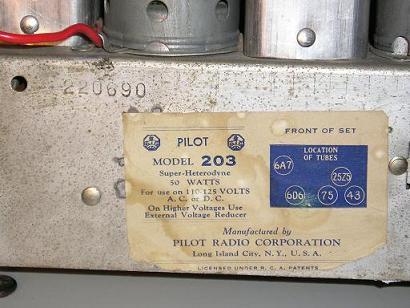- Produttore / Marca
- Pilot Electric Mfg. Co. (Radio Corp.); Brooklyn (NY)
- Anno
- 1936
- Categoria
- Radio (o sintonizzatore del dopoguerra WW2)
- Radiomuseum.org ID
- 51776
-
- alternative name: Pilot Radio & Television || Pilot Radio and Tube || Pilot Radio Corporation
Clicca sulla miniatura dello schema per richiederlo come documento gratuito.
- Numero di tubi
- 5
- Principio generale
- Supereterodina (in generale); ZF/IF 456 kHz
- N. di circuiti accordati
- 6 Circuiti Mod. Amp. (AM)
- Gamme d'onda
- Onde medie (OM) e corte (OC).
- Particolarità
- Giradischi o cambiadischi
- Tensioni di funzionamento
- Alimentazione universale (doppia: CC/CA) / 110 Volt
- Altoparlante
- AP elettrodinamico (bobina mobile e bobina di eccitazione/di campo) / Ø 5 inch = 12.7 cm
- Potenza d'uscita
- 1 W (qualità ignota)
- Materiali
- Bachelite
- Radiomuseum.org
- Modello: 203 [76 tube] - Pilot Electric Mfg. Co. Radio
- Forma
- Soprammobile verticale con decorazioni (Tombstone).
- Dimensioni (LxAxP)
- 237 x 320 x 180 mm / 9.3 x 12.6 x 7.1 inch
- Annotazioni
- This tube lineup is well documented in Riders. Nevertheless there are definitely models using a 75 tube (see there).
- Peso netto
- 3.5 kg / 7 lb 11.3 oz (7.709 lb)
- Fonte esterna dei dati
- Ernst Erb
- Fonte dei dati
- The Radio Collector's Directory and Price Guide 1921 - 1965
- Riferimenti schemi
- Rider's Perpetual, Volume 7 = 1936 and before
- Altri modelli
-
In questo link sono elencati 544 modelli, di cui 271 con immagini e 408 con schemi.
Elenco delle radio e altri apparecchi della Pilot Electric Mfg. Co. (Radio Corp.); Brooklyn (NY)
Collezioni
Il modello 203 fa parte delle collezioni dei seguenti membri.
Discussioni nel forum su questo modello: Pilot Electric Mfg.: 203
Argomenti: 4 | Articoli: 6
To get optimum search I put the obvious identical models 203 (75 tube) and X203 together. Now both ways to search will arrive at the model "203 (X203)". And the model with 76 tube is also clearly defined.
To use early and late would not help. A collector looking for info in RM would never find such a hint on his radio. In our case here the tubes are unambiguous means to discriminate.
In addition "early" and "late" as found in some Sylvania Service notes are in doubt insofar, as both versions are noted for the same year 1936 (Riders vs. Machine Age).
Konrad Birkner † 12.08.2014, 19.May.07
Gentlemen,
First of all: I would like to limit this research action to models of identical appearance as there are 203, 205, X203, X205 (and still candid ones, who knows).
Pilot caused a mess here: The label is for an X203 (for USA).They forgot to stamp an X in front of the number. The European version would be the X205. These models are using the 75 and a 25L6.<br>The 203 (without X) is the US model, its European version is the 205. These models use a 76 and a 43.
The label pictured at 203 shows a combination of 75 and 43, and it says 115 Volt but the set is for 220-240 Volts.
Are there other variations known? I need to know: tube lineup, mains, wavebands, labelling.
Please mail, that I can collect info, sort out and create variants, when as much info as possible will be available.
Please no precipitate actions. Corrections are more time consuming than a complete tidying action.
Thanks
Konrad Birkner † 12.08.2014, 14.Feb.07
Here it is the Ivory version, kindly sent by Mr. António Manuel dos Santos from Coimbra-Portugal.
It is already uploaded in this model's tread.
Thank you Mr. António.
Mario Coelho, 27.Aug.05
Dear Friends
I've now one USA Pilot model 203
http://www.radiomuseum.org/dsp_modell.cfm?model_id=51776
As You can see it was made in USA. It is written in its label on chassis.
Its tubes are 6A7; 6D6;75 (not 76*); 43 and 25Z5.
* Not 76 as you can see in http://www.nostalgiaair.org/Resources/309/T0000309.htm but is very clear 75 in its label.
So I think this option (tube 75) might be considered in observations.
Thank you for your time
Mário Coelho
Mario Coelho, 05.Mar.05








